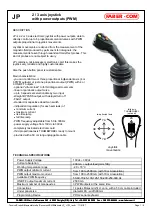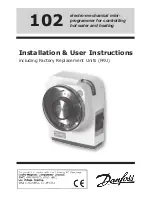
Revision 1.1
Page 11 of 21
Warning
Please Note
The specifications of the product detailed on this
Set-Up Guide may change without notice. RDM
Ltd. shall not be liable for errors or for incidental
or consequential damages, directly and indirectly,
in connection with the furnishing, performance or
misuse of this product or document.
Ensure that all power is
switched off before
installing or maintaining
this product
Mercury 2 & Intuitive Mobile Controller User Guide
www.resourcedm.com
P-15
Probe 5 Select
This input can be used as a defrost termination probe (default) or as a monitor probe with an OT alarm
level (P-28)
P-16
Relay 3 mode
This changes the function of relay 3 from Lights (default) to an alarm relay. The alarm relay is energised
for no alarm. Use the NC and Common for “Loop make” on alarm or use the NO and Common for “Loop
break” on alarm.
P-29
Probe 1 or Probe 3
Resistor
Selects whether the switched resistor invokes either a Plant fault or an External Defrost.
P-18
Service Interval Time
(Run Hours)
Time (in 1000 x hours) before the service icon (Spanner icon) comes on. The Run Hours timer increments
based on the number of hours the controller has been powered up and running. Reset the spanner icon to
off by changing this parameter to 0 and then back to the desired service interval. This process also resets
the Run Hours value to 0. To view the current Run Time value refer to the I/O list.
P-19
Switch Resistors
Enables switched resistors to be used for Plant Faults, External Defrosts, Case Clean.
See :
Switched Resistor Values
P-98
Lights Case Off
Used to place the controller into Case Off when its lighting timer is in the off state. When the lighting timer
is in the on state the controller follows its normal control operation. This feature is disabled if the set point
(P-01) is below 6
o
C. Please note that when the controller is in case off all alarms are inhibited and all
outputs are turned off. Therefore care must be taken when enabling this parameter.
Off
– Feature is not used and only the controller lights relay follows the lighting timer status.
On - Feature is in use and controller will be in Case Off whenever the lights timer is in the off
state.
Unused
– This selection has no effect and should not be used. Please select from either Off or
On. This feature operates in either Local, using controller RTC, or Remote, using Data Manager
GP timer channel, lighting applications.
P-99
Load Shedding
Off
– Feature is not used
Mode 1
– Case goes to “CO2 Load Shedding Case Off Mode”
Mode 2
– Goes to Case Clean Mode
See:
Load Shedding
P-30
Do Discharge Stop
Compressor A
This enables the discharge stop on compressor A, if set to ON then the compressor will be disabled if the
discharge temperature is exceeded.
P-31
Do Discharge Stop
Compressor B
This enables the discharge stop on compressor B, if set to ON then the compressor will be disabled if the
discharge temperature is exceeded.
P-32
Discharge Stop Value
If a compressor discharge probe exceeds this value and P-30 and P-31 are set to ON then the relevant
compressor will be disabled.
P-33
Discharge Stop
Differential
This is the differential below the discharge stop value that the discharge probe temperature has to drop
before the compressor is enabled again.
P-34
Maximum Compressor
Run Time
This limits the running time of any compressor, once the compressor has exceeded this time period it will
be switched off for the period of the anti short cycle time (P-06)
P-35
Comp Stop Both
If either compressor stops due to expiry of the Maximum Compressor Run Time then both compressors
will be disabled if P-35 is set to On.
P-20
Alarm Delay
Delay for the over and under-temperature alarms
P-21
UT Alarm
Under temperature alarm set point. This alarm uses the control temperature.
P-22
OT Alarm
Over temperature alarm set point. This alarm uses the air-off temperature.
P-23
Log Probe Type
Allows the user to set the logging probe mode: -
Off
Logging with no alarms
Logging with alarms
P-24
Slug Log Probe
Applies a damping factor. This can be used to make a standard probe have the same temperature
response as a logging probe.
P-25
Log Alarm Delay
Delay for the Logging probe over and under-temperature alarms
P-26
Log UT Alarm
Logging probe under temperature alarm set point
P-27
Log OT Alarm
Logging probe over temperature alarm set point
P-28
Monitor OT Alarm
Monitor probe over temperature alarm set point
P-40
Defrost Mode
Allows the user to set the defrost mode: -
Local (Uses the internal parameters P-41 and P-42)
Remote (Requires a defrost schedule in the front end)
External (uses a switched resistor in input 3 ). When this signal is present a defrost is initiated.
Note: -
If the external defrost signal is not removed then the controller will defrost according to the “No
Defrost” time and a missed defrost alarm will be generated. See P-29 for external defrost signal setup.
P-41
Defrost Start
When defrost mode is set to “Local”, this is the start time for the 1
st
defrost
P-42
Defrosts per Day
When defrost mode is set to “Local”, this is the number of defrosts per day equally spaced from the start
time.
P-43
No Defrost Time
If the controller misses a defrost command for any reason, a defrost will initiate after this time has elapsed
from the last defrost. Normally set to 2 hours over the normal defrost interval period.
P-44
Def Terminate
The defrost will terminate (defrost control relay off) when the temperature of the defrost termination probe
reaches this value, if a defrost probe is not fitted then the air off program will be used.
P-45
Def Min Time
Minimum time that a defrost will use (Defrost can’t terminate until this time has elapsed. If termination
temperature is reached during this period, the defrost control relay is turned off but the controller will not
start refrigerating until the end of the defrost min period)







































